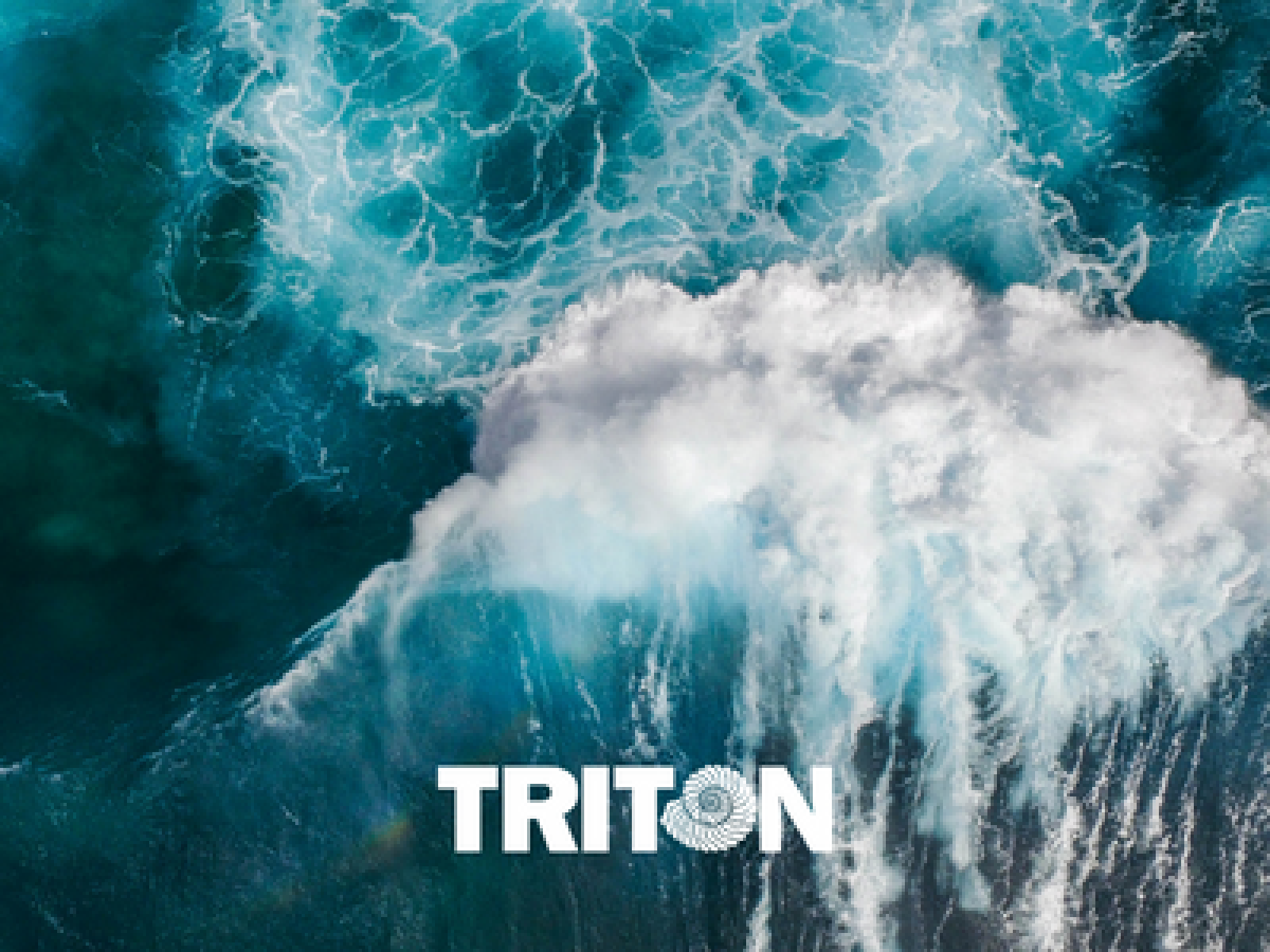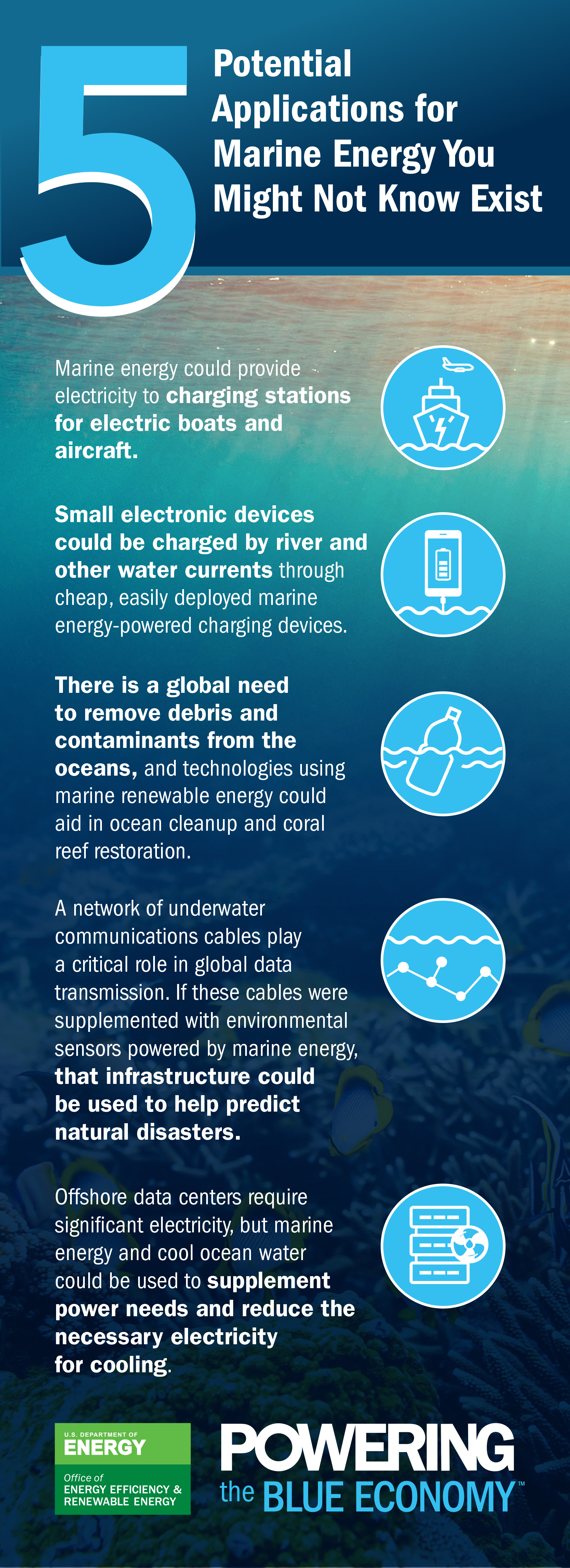Making Waves for Marine Energy: Triton from the Water Power Technologies Office Perspective with Samantha Eaves

Have you ever thought about how government-funded science leads to technology developments that benefit our nation? Samantha Eaves has. She is the environmental research and instrumentation sub-activity area lead in the Marine Energy program for the U.S. Department of Energy (DOE) Water Power Technologies Office (WPTO).
According to the Energy Act of 2020, marine energy includes any energy harnessed from waves, tides, currents, estuaries, and naturally flowing water, which includes river streams, differentials in salinity gradients, and ocean thermal energy conversion. With thousands of miles of coastline and an abundance of rivers, the United States has significant resources to utilize marine energy in our communities. WPTO maximizes the potential of those natural energy resources. Eaves' role in this effort is to advocate for projects that move the marine energy industry forward while integrating an environmentally sustainable approach. She manages a portfolio of environmental and regulatory-focused marine energy projects, including the Pacific Northwest National Laboratory Triton Initiative.
Triton is a multidimensional project that researches methods and technologies for environmental monitoring around marine energy applications. Triton researchers seek to understand the potential risks associated with tidal and wave energy devices through researching underwater noise and electromagnetic fields, and studying marine animal interactions and changes in habitats. Triton's contributions to the marine energy industry expand our understanding of the state of environmental monitoring research and provide recommendations to regulators on best practices for monitoring around marine energy sites. Eaves' leadership and vision are essential components in Triton’s success.

Since her undergraduate studies, Eaves has pursued research in biology and aquatic systems, including participating in the National Science
Foundation’s Research Experience for Undergraduates program studying zooplankton with the Great Lakes WATER Institute and acquiring industry experience testing contaminants in soils. These experiences led her to continue her education at the Virginia Institute for Marine Science at the College of William and Mary, where she received her master's and PhD studying zooplankton and bacterial roles in biogeochemical cycling. She was awarded the National Oceanic and Atmospheric Administration Sea Grant Knauss Marine Policy Fellowship, which brought her to the WPTO, where she now leads the strategic environment and instrumentation work for the Marine Energy program.
The future of marine energy
The potential for marine energy in the United States is expansive. According to a recent DOE report, Marine Energy in the United States: An Overview of Opportunities, the total marine energy resource in the United States is 2,300 TWh/yr, or about 57 percent of the electricity generated by all 50 states in 2019. The research is currently at a point where technical capabilities of marine energy can be demonstrated. However, data still need to be collected to fill the remaining gaps in understanding of environmental impacts before deploying new technologies. The industry is currently focused on small demonstrations of devices in open water. These tests make sure ecological and public safety is upheld while helping marine energy move closer to large-scale production. Eventually, the plan is for small-scale demonstrations to transition to larger-scale commercial systems. These systems align with the U.S. mission to reduce carbon emissions, contribute clean energy to the grid, and power various aspects of our lives. Triton helps build confidence in the environmental sustainability of these devices and helps provide the industry with cost-effective, user-friendly ways to collect evolving data.
There are still technical obstacles and regulatory challenges the marine energy industry must face before tidal and wave energy become active parts of the United States' energy portfolio. The regulatory process is imperative, but the limited amount of science-based evidence creates a barrier for marine energy developers to obtain permits to rapidly install and test devices. WPTO funds projects to directly address these limitations and reduce the barriers to the testing and deployment of marine energy devices. Eaves’ goal is to understand how government-funded science can best provide the information needed for effective regulatory decisions. She relies on researchers at government laboratories like the Pacific Northwest National Laboratory to generate science-based evidence and recommendations for methodologies to satisfy permitting requirements. An overarching goal of the projects managed by Eaves, like Triton, is to make sure research efforts align with regulatory and industry needs and ensure there are cost-effective technology solutions rooted in science.
Why Triton
Eaves has been with Triton since its genesis in 2015. Project sponsors perform various activities, including securing budgets for projects; discussing project status with government-laboratory project teams; working with researchers to meet project goals; and guiding strategic visions for projects. As a project sponsor, Eaves supports Triton’s cutting-edge research, all while making sure the needs of regulators and other stakeholders are met.
"Triton takes advantage of the unique location and infrastructure (at the Marine and Coastal Research Laboratory) and provides a site to test monitoring technologies uniformly, allowing consistent evaluation in a controlled environment," says Eaves. One pillar of the Triton work is to support DOE-funded projects dedicated to developing innovative environmental monitoring technologies and advancing their technical readiness level (read more here). "All of the outside partners who have worked with Triton have said it has been a great experience," claims Eaves, "This positive feedback is a testament to the high-quality work and personnel we attract to the program." Eaves appreciates the support aspect of Triton and how the technology development process is streamlined in an environment designed to work through research questions and overcome development challenges. Many DOE-funded projects will complete their final technology readiness demonstrations at wave energy test sites in the coming year. Eaves is excited to see the results of years of hard work preparing these technologies for testing in the presence of marine energy devices. The Triton team will test environmental monitoring devices around the CalWave wave energy converter planned to be deployed off the Scripps Institution of Oceanography’s pier in La Jolla, California, and around several wave energy converters scheduled to test at the Wave Energy Test Site on the Kaneohe Marine Corps Base in Hawai’i.
Over the past six years, Eaves has watched Triton grow from a small, two-person project to a dynamic program of experts contributing important thought leadership to the field of environmental monitoring for marine energy. Triton started with technology development support and has expanded its research with the Triton Field Trials (TFiT). TFiT studies methods and instrumentation for understanding the potential effects of the four main stressors associated with marine energy: changes in habitat, electromagnetic fields, underwater noise, and collision risk. To improve environmental monitoring practices and data transferability for marine energy deployments, TFiT conducts field studies to test various methods for monitoring these stressors and will develop recommendations for stakeholders on best practices. With Triton’s diverse team, TFiT is able to incorporate predictive modeling, technical development, and data processing expertise into these recommendations to provide informed guidance. DOE funds projects that produce science-based results and easily implemented, cost-effective technology. Eaves' role connects the importance of taxpayer-funded research to national challenges, making sure that results benefit the nation—a major reason why the development of field-tested environmental monitoring recommendations is a critical component of Triton's research.
Eaves says the industry is at the point where marine energy technologies are becoming more familiar, but evaluations of the environmental effects are still needed. With that comes a need to access low-cost, intuitive monitoring technologies, so developers can conduct necessary environmental monitoring without being experts in environmental stressors. Eaves feels the TFiT recommendations will help fill this need, and thinks Triton has a future leading the development of cost-effective and user-friendly tools to address gaps in environmental monitoring.
Eaves' hopes for the future

“We are at a unique time,” says Eaves. “With marine energy deployments going forward and the current administration’s focus on clean energy and addressing environmental concerns, I see marine energy playing an important role in helping meet the energy needs of the United States, especially on small, local scales.” Tidal and wave energy applications are an opportunity to power the blue economy in ways people don’t often think of, such as providing energy for marine transportation or supporting offshore communications (read more here). These smaller marine energy applications will enable much-needed demonstrations before larger-scale, integrated grid applications for coastal communities can be deployed. For this reason, Eaves is looking forward to the upcoming deployments with CalWave and Hawai'i Wave Energy Test Site. These deployments are an opportunity to build up the knowledge base of environmental monitoring data and build confidence in the sustainability of wave energy devices. Increased testing will ultimately create less of a need for data collection and transferability, providing space for exploring more complex questions, such as impacts of larger arrays, or deployments of new types of marine energy technologies.
Eaves also recognizes the value of communication, outreach, and engagement to educate the nation about the marine energy industry and WPTO’s renewable energy goals. Since taxpayers fund WPTO’s research, it’s important to demonstrate good stewardship of taxpayer dollars and be transparent about what projects receive funding and why. It is also crucial to make sure researchers, stakeholders, and the general public all build familiarity with the marine energy industry and understand the benefits of the technologies. Wave, tidal, and other marine energy resources will inevitably gain attention as deployments continue and technologies move closer to becoming commercially viable renewable energy sources for the United States. For diverse audiences to understand how the industry works to make sure marine energy is safe for people and the planet, the science needs to be effectively communicated.
Through WPTO's project work, stakeholder engagement, and dedication to communications, the future of marine energy is looking bright. If you are interested in learning more about WPTO’s mission, the future of marine energy, or the state of environmental monitoring research, check out these resources:
- Stay current with the Water Power Technologies Office: Sign up for The Water Wire email.
- Triton Initiative
- U.S. Department of Energy Water Power Technologies Office
- The Portal and Repository for Information on Marine Renewable Energy (PRIMRE)
- Tethys Knowledge Base
Written by Cailene Gunn.
Subscribe to our monthly newsletter here.
Published: May 4, 2021